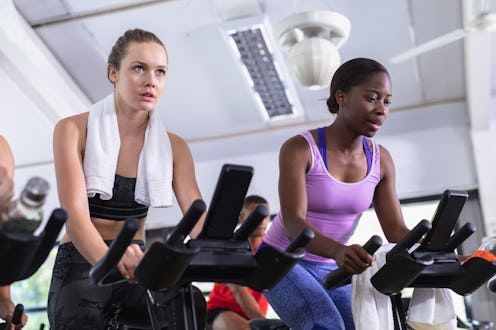Fitness
These Are All The Muscles You Work In A Cycling Workout
So *that’s* why your abs are sore after spin class.

In a spin class, you definitely feel the burn in your legs as you pedal and grind uphill. But afterwards, you may feel soreness in other parts of your body — and that’s because cycling is actually considered a great full-body workout, according to Peloton instructor Camila Ramón.
So what muscles does cycling work? Ramón points to muscles within your upper, middle, and lower body. To ensure you’re engaging all the proper muscle groups, however, your bike needs to be set up in the right position for your body. “Bike fit is a huge part of proper muscle recruitment,” Ramón says, so check in with an instructor before your ride, or use your bike’s guide to ensure the seat height is correct. According to Teddy Savage, the head of health and fitness at Planet Fitness gyms, you’ll know you’re in the proper position if your leg straightens at the bottom of a pedal, with a slight flex in your foot and knee. Adjust the seat, then hop on and bend forward at your hips while keeping your core engaged and spine neutral. Grip the handlebars about shoulder-width apart with your elbows slightly bent, and you should be good to go. “When cycling off-seat, ensure that your body weight is slightly forward and keep good tension on the lower body throughout the ride,” Savage explains.
From there, the level of resistance is what’ll work your muscles when cycling. According to Ramón, the resistance level is also what helps you maintain overall control. If it’s too low, you’ll pedal too fast and bounce around in your seat. If the resistance is right, you’ll fully utilize the power of each pedal to propel yourself forward. Whether you’re riding in a class, at home, or even out on the road, here are all the muscle groups you’ll hit while cycling.
The Muscles You Work When Cycling
Quads & Glutes
First up, you’re working two major lower body muscles: the quadriceps on the front of your thighs, and the glutes. “The quads and glutes help extend the knee from its most bent position into the downward motion of the pedal stroke,” Ramón explains.
Hamstrings
As you move through the pedaling motion, it’s the hamstrings on the back of your legs that bring the pedal back up, Ramón says. You’ll need to clip your feet into the pedals to pull up and engage these muscles.
Calves
The calves play a major role in aiding the upper leg with the pedal stroke, as well as with dorsiflexion and general control of foot positioning, Ramón says. According to Savage, they’re also one of the prime “movers” in the cycling motion.
Core
You might not think the core has anything to do with cycling, but a strong midsection is what helps you maintain good posture throughout a ride, which Savage says is a straight back, neutral spine, and engaged core. Cycling outdoors will engage your core even more, Ramón says, since outdoor bikes tend to have lower handlebars.
Stabilizer Muscles
There are lots of stabilizer muscles that work together to help you stay balanced and upright when cycling. They‘re also responsible for allowing your primary muscles to unleash their full power. “When riding outside there definitely is an increased demand for a well-developed sense of proprioception and recruitment of stabilizer muscles since outdoor cycling is more unstable and requires balance to respond to micro-adjustments and turns,” Ramón explains.
Lats
Cycling also hits the latissimus dorsi, or lats, on your back. “The lats really come into play when doing work out of the saddle,” Ramón says. This is something many cycling classes encourage for folks who are more experienced. You’ll lift up out of your seat and pedal while standing to mimic riding uphill.
Arms
While cycling isn’t considered an upper body workout, you do use your arms in a key way. “The upper body is important for the various grips along the handlebars and the slight flexion in the elbow,” Savage says. “This triggers muscles in the forearms, triceps, and shoulders.”
Common Cycling Mistakes To Avoid
As you ride, check in with your posture to ensure you aren’t slumped forward or leaning too heavily on the handlebars. Savage says it’s common for cyclists to round their back, but doing so puts stress on the lower lumbar and can lead to injury over time.
For a quick fix, Ramón recommends bringing your handlebars up a bit higher and staying in the saddle as you ride and develop strength. You’ll also want to stick to your own pace. “When taking a class it’s important to realize that the numbers being given are not mandatory,” she adds. “If you need to go lower in resistance or cadence, that’s OK as long as you follow the safety parameters.”
How Long Does It Take To Build Strength?
The experts recommend aiming to cycle three to five times a week. As you build muscle strength and up the intensity, you’ll eventually be able to ride for longer distances, complete intervals, and ride uphill with greater ease.
“When done consistently, you can start feeling increased strength in a matter of weeks,” Savage says. “The most important aspect is to stay consistent and not try to do too much, too soon. This can lead to overexertion or injury. Strength will come as a byproduct of conditioning the muscles over time.”
Studies referenced:
Abt, J. (2007). Relationship Between Cycling Mechanics and Core Stability. The Journal of Strength and Conditioning Research. DOI:10.1519/R-21846.1
Lima da Silva, J. (2016). Quadriceps and hamstring muscle activity during cycling as measured with intramuscular electromyography. Eur J Appl Physiol. https://www.ncbi.nlm.nih.gov/pmc/articles/PMC4983295/
McDaniel, J. (2005). Torso stabilization reduces the metabolic cost of producing cycling power. Can J Appl Physiol. https://pubmed.ncbi.nlm.nih.gov/16258182/
Experts:
Camila Ramón, Peloton instructor
Teddy Savage, head of health and fitness at Planet Fitness gyms